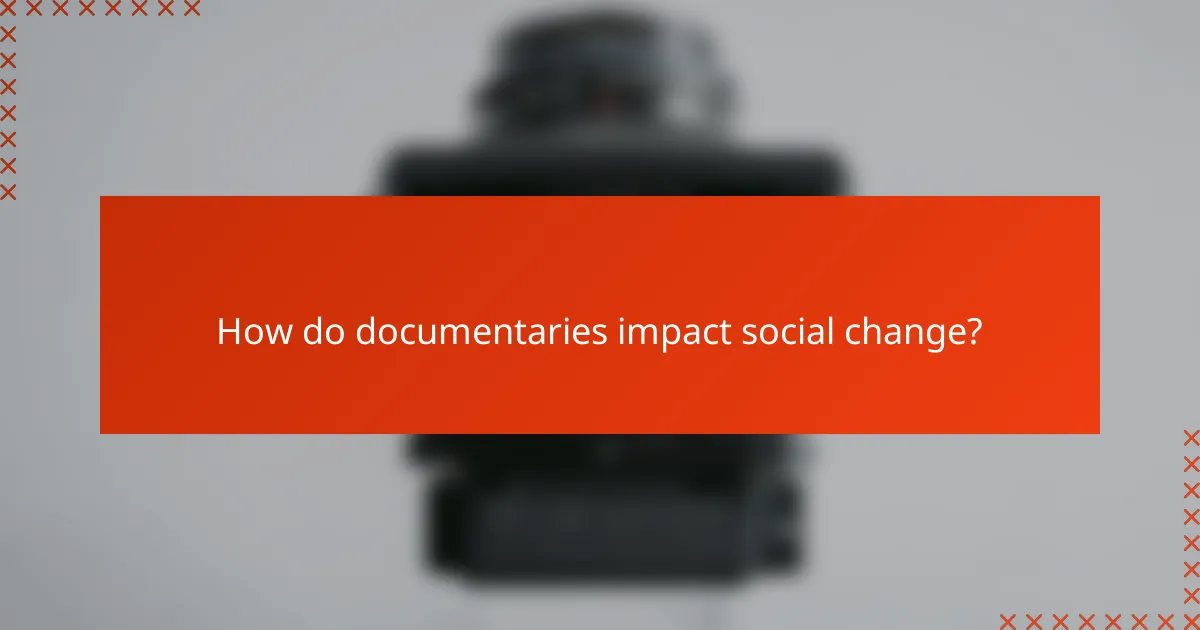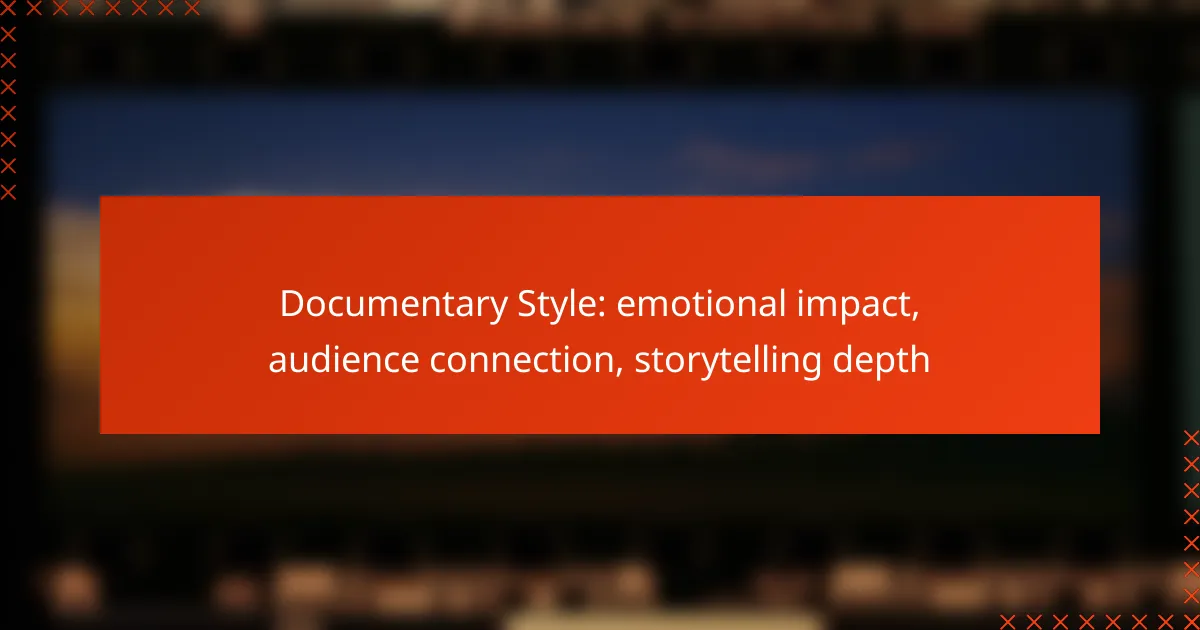Documentary filmmaking harnesses the power of authentic narratives to evoke deep emotional responses and connect with audiences on a personal level. By weaving together real-life stories, character-driven narratives, and relatable themes, documentaries create an immersive experience that resonates profoundly with viewers. Through layered storytelling and expert insights, filmmakers invite audiences to explore complex subjects with empathy and understanding.

How does documentary style create emotional impact?
Documentary style creates emotional impact by engaging the audience through authentic narratives and relatable experiences. By presenting real-life stories and emotions, documentaries foster a deep connection that resonates with viewers on a personal level.
Use of personal stories
Personal stories are central to documentary filmmaking, as they provide a human element that viewers can relate to. By focusing on individual experiences, filmmakers can evoke empathy and understanding, making complex issues more accessible. For instance, a documentary about climate change might feature a farmer whose livelihood is threatened, allowing the audience to grasp the real-world consequences of environmental issues.
To maximize emotional impact, filmmakers should select stories that highlight universal themes such as struggle, resilience, or hope. This approach not only captivates the audience but also encourages them to reflect on their own lives and values.
Visual storytelling techniques
Visual storytelling techniques enhance the emotional depth of documentaries by using imagery to convey feelings and narratives. Techniques such as close-up shots can capture subtle expressions, while wide shots can illustrate isolation or community. The choice of colors and lighting also plays a crucial role; warmer tones can evoke comfort, while cooler tones may suggest sadness or tension.
Effective use of visual metaphors can further deepen the audience’s emotional engagement. For example, showing a decaying building alongside a vibrant community can symbolize resilience amidst adversity, prompting viewers to consider the complexities of the subject matter.
Music and sound design
Music and sound design are powerful tools in documentaries that significantly influence emotional responses. A well-chosen score can elevate the narrative, guiding the audience’s feelings and enhancing moments of tension or joy. For instance, a haunting melody can underscore a poignant scene, making it more memorable and impactful.
Sound design also includes ambient sounds that create a sense of place and immersion. The sounds of nature, urban life, or personal conversations can ground the viewer in the story, making it feel more immediate and real. Filmmakers should carefully consider how sound complements visuals to create a cohesive emotional experience.

What techniques enhance audience connection in documentaries?
Techniques that enhance audience connection in documentaries include character-driven narratives, authentic interviews, and relatable themes. These elements create emotional resonance and foster a deeper understanding of the subject matter.
Character-driven narratives
Character-driven narratives focus on individuals whose stories embody larger themes or issues. By following a specific character’s journey, audiences can form emotional bonds and engage more deeply with the content. This approach often highlights personal struggles, triumphs, and transformations, making the documentary feel more relatable.
To effectively implement character-driven narratives, filmmakers should select subjects with compelling backstories and clear motivations. For example, a documentary about climate change might center on a farmer whose livelihood is threatened by changing weather patterns, allowing viewers to connect personally with the broader issue.
Authentic interviews
Authentic interviews are crucial for establishing credibility and emotional depth in documentaries. When interviewees share their experiences candidly, it fosters trust and allows the audience to empathize with their perspectives. This authenticity can be achieved by creating a comfortable environment where subjects feel safe to express their thoughts and feelings.
Filmmakers should strive to ask open-ended questions that encourage detailed responses. For instance, instead of asking, “What do you think about this issue?” a more effective question might be, “Can you share a personal experience related to this issue?” This approach invites richer storytelling and deeper connections.
Relatable themes
Relatable themes resonate with audiences by reflecting universal human experiences such as love, loss, struggle, and resilience. When documentaries explore these themes, they can transcend cultural and geographical boundaries, making the content accessible to a wider audience. This connection often leads to a more impactful viewing experience.
To identify relatable themes, filmmakers should consider the core message of their documentary and how it aligns with common human emotions. For example, a documentary about addiction might explore themes of redemption and hope, allowing viewers to connect with the subject matter on a personal level, regardless of their background.

How can storytelling depth be achieved in documentaries?
Storytelling depth in documentaries can be achieved through various techniques that enhance emotional impact and audience connection. By employing layered narratives, integrating historical context, and incorporating expert commentary, filmmakers can create a more immersive and engaging experience for viewers.
Layered narratives
Layered narratives involve weaving multiple storylines or perspectives into a single documentary. This technique allows filmmakers to present complex themes and emotions, making the story richer and more relatable. For example, a documentary about climate change might include personal stories from affected communities alongside scientific data and expert insights.
When using layered narratives, consider how each layer interacts with the others. Ensure that transitions between stories are smooth and that each narrative thread contributes to the overall message. This approach can deepen emotional engagement and foster a stronger connection with the audience.
Historical context integration
Integrating historical context into a documentary provides viewers with a framework to understand the present. This can involve referencing past events, cultural shifts, or significant milestones that have shaped the subject matter. For instance, a documentary on civil rights might include footage from key historical protests to highlight progress and ongoing struggles.
To effectively integrate historical context, use archival footage, photographs, or expert interviews that contextualize the current narrative. This not only enriches the storytelling but also helps viewers grasp the significance of the issues being discussed, making the documentary more impactful.
Expert commentary
Incorporating expert commentary adds credibility and depth to a documentary. Experts can provide insights, analyze data, and explain complex concepts, helping viewers understand the subject matter more thoroughly. For example, a documentary on health issues could feature doctors or researchers discussing the latest findings and their implications.
When selecting experts, ensure they are relevant and respected in their fields. Balance expert commentary with personal stories to maintain emotional resonance while providing factual depth. This combination can enhance the documentary’s overall effectiveness and keep the audience engaged.

What are the key elements of effective documentary storytelling?
Effective documentary storytelling hinges on a few essential elements that create emotional impact and foster audience connection. These elements include a clear structure, engaging visuals, and compelling pacing, all of which work together to enhance the storytelling depth.
Clear structure
A clear structure is vital for guiding the audience through the narrative. It typically involves a beginning that introduces the topic, a middle that develops the story, and an end that provides resolution or insight. This logical flow helps viewers stay engaged and understand the progression of ideas.
Consider using a three-act structure or thematic segments to organize content. Each segment should build upon the previous one, leading to a satisfying conclusion that resonates emotionally with the audience.
Engaging visuals
Engaging visuals are crucial in documentaries as they capture attention and evoke emotions. High-quality footage, compelling imagery, and thoughtful composition can significantly enhance the storytelling experience. Use a mix of interviews, archival footage, and b-roll to create a rich visual tapestry.
Incorporating graphics or animations can also clarify complex topics. Ensure that visuals support the narrative rather than distract from it, maintaining a cohesive visual style throughout the documentary.
Compelling pacing
Compelling pacing keeps the audience invested in the story. Varying the rhythm of the narrative can create tension or provide relief, guiding emotional responses. Quick cuts can heighten excitement, while slower moments allow for reflection on important themes.
Pay attention to the duration of segments; aim for a balance that maintains interest without overwhelming viewers. A well-paced documentary typically runs between 60 to 90 minutes, ensuring ample time for storytelling without losing momentum.

What role does audience feedback play in documentary production?
Audience feedback is crucial in documentary production as it helps filmmakers understand viewer perceptions and emotional responses. This feedback can guide creative decisions, ensuring the final product resonates with its intended audience.
Testing concepts with focus groups
Focus groups are an effective way to test documentary concepts before final production. By gathering a diverse group of potential viewers, filmmakers can gauge initial reactions to themes, narratives, and visuals. This process often reveals insights that can shape the direction of the documentary.
During focus group sessions, filmmakers should prepare specific questions and prompts to encourage discussion. Observing body language and emotional responses can provide valuable qualitative data that goes beyond simple ratings.
Adapting based on viewer reactions
Adapting a documentary based on viewer reactions can significantly enhance its impact. Filmmakers should be open to making changes in response to feedback, whether that involves altering the narrative structure, pacing, or even the inclusion of additional content. This flexibility can lead to a more engaging final product.
For instance, if focus groups indicate that certain segments evoke strong emotional responses, filmmakers might choose to expand on those elements. Conversely, if parts of the documentary feel confusing or disengaging, they can be revised or removed to improve clarity and connection with the audience.

How do documentaries impact social change?
Documentaries can significantly influence social change by raising awareness, shaping public opinion, and inspiring action. Through compelling storytelling and emotional engagement, they connect audiences to critical issues, often prompting viewers to advocate for change.
Emotional engagement in storytelling
Emotional engagement is a key element in documentary storytelling that fosters a deep connection between the audience and the subject matter. By presenting personal narratives and real-life experiences, documentaries evoke empathy and provoke thought, making complex issues more relatable.
For instance, a documentary highlighting the struggles of a marginalized community can humanize statistics, allowing viewers to grasp the emotional weight of social issues. This connection often motivates audiences to take action, whether through advocacy, donations, or community involvement.
Building awareness and understanding
Documentaries serve as powerful tools for building awareness and understanding of social issues that may be overlooked or misunderstood. They often present facts, expert opinions, and personal stories that illuminate the nuances of a topic, encouraging viewers to reconsider their perspectives.
For example, a film addressing climate change might combine scientific data with personal accounts from affected individuals, creating a comprehensive picture that resonates with viewers. This multifaceted approach can lead to increased public discourse and policy discussions.
Inspiring action and advocacy
Many documentaries aim to inspire action and advocacy among viewers. By showcasing the impact of social issues and the potential for change, they encourage individuals to become involved in movements or initiatives that address these challenges.
Documentaries often include calls to action, providing viewers with specific steps they can take, such as signing petitions, joining organizations, or participating in local events. This direct engagement can transform passive viewers into active participants in social change.



